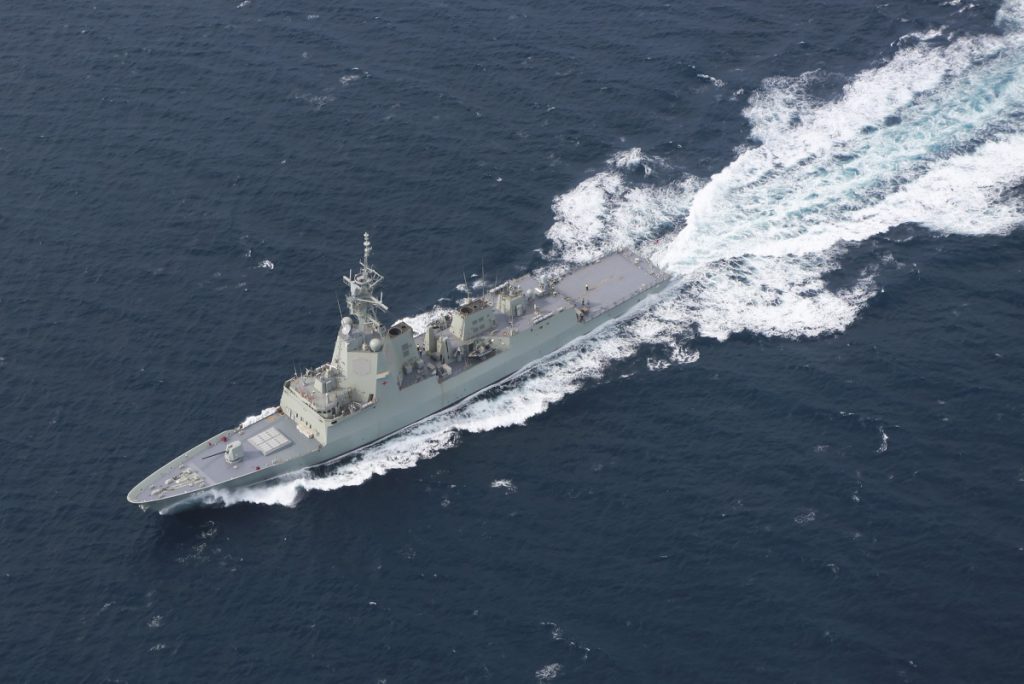
Australia has historically taken a stop-start approach to naval shipbuilding, investing in a mixture of domestic- and foreign-sourced warships at uneven increments. The current Australian government is planning to invest tens of billions of dollars on development of a long-term, sustainable shipbuilding industry in Australia. To successfully implement this national enterprise, a number of challenges need to be addressed; one is the service life of individual warships.
Navy warships are typically in-service for 30–35 years, and receive a mid-life upgrade to keep their capabilities up-to-date. If a fleet stays roughly the same size, that means that there’s a 30-year replacement cycle. That’s not a problem for a large navy like the USN, but Australia has only eleven frigate-sized surface combatants and six submarines. Even though future plans include 12 new surface combatants (three AWDs and nine future frigates) and twelve submarines, an even pace of construction would produce one submarine and one surface ship every 2.5 years, which isn’t likely to be an optimal tempo from a design and construction perspective.
There are probably multiple ways to address that problem, and none are likely to be perfect. We decided to investigate the potential cost impact of reducing a warship’s service life to 20 years and forgoing the mid-life upgrade. The full details can be found in our new ASPI report, released today, but the short story is that it appears to be a viable option.
To elaborate, the answer to the question of whether it’s cheaper to give a warship a mid-life upgrade or just build a new one is: it depends. The long-term costs of fleet modernisation are driven more by the costs of chosen capabilities than whether those capabilities are delivered through an upgrade or a new build.
While the overall costs of individual vessels have been steadily increasing for decades, so have their capabilities. The driving factors for that trend have been examined elsewhere, and are partially addressed in our paper. It doesn’t feature in our analysis, but the impact of increasing capability costs on the continuous shipbuilding program would be another question worth exploring—especially if fleet numbers are intended to stay the same. Our analysis looked at the build and upgrade costs for the Adelaide-class FFGs, ANZAC-class frigates, and the Collins-class submarines. By assuming that each vessel was built for 20 years of life, and that an upgrade afforded it an additional ten years, we were able to compare the cost-effectiveness of either strategy.
For example, the upgrades to the Adelaide-class FFGs increased the average cost per year of service for the class, but some of them have already served for more than 30 years. By comparison, the upgrades to the ANZAC frigates has had the opposite effect—lowering the average cost per year of service—but it’s not entirely clear yet whether more upgrades will be needed to keep them at high levels of capability until they’re replaced.
A shipbuilding program that prioritises value for money would include replacement as an option when considering possible upgrades. This way, once the appropriate level of capability is determined (based on an analysis of strategic circumstances), the Defence Department could evaluate the most cost-effective way to deliver the capability, regardless of whether it’s by upgrade or replacement.
In the transition to a continuous shipbuilding program, an overt plan to replace vessels on a 20-year cycle could make the process more efficient. Compared to the 30-year life cycle, 12 surface ships and 12 submarines every 20 years is equivalent to one of each per 20 months. That’s still a little slow by global standards, but it’s more sustainable. And the quicker tempo enables new or upgraded capabilities to be introduced as part of the design and construction program.
We’re not advocating any specific path for Navy’s future capability development plans, but our analysis suggests there are at least two broad options for the continuous shipbuilding strategy. And having more options is almost always a good thing, especially in strategically challenging times.
As the Australian government lays the keel on an ambitious naval shipbuilding program, it’s important to recognise that what may have worked in the past isn’t automatically the most appropriate way of doing business in the future. The Department of Defence has access to more and better data than we in the open-source world, and we’d encourage them to conduct their own cost-comparison of ship service lives. Until then, you can enjoy the full version of our paper.

